Sue Newman, a 1991 Soil and Water Sciences Ph.D. alumna, reflects on her time at UF and her career at the South Florida Water Management District. As a scientist with SFWMD, she has focused on restoring the Everglades for nearly 30 years. Specifically, her work revolves around phosphorus.
Sue Newman’s interest in science began in childhood. It led her to study at the University of Manchester Institute of Science and Technology in Manchester, England. There she earned a Bachelor of Science Honors degree in Management and Chemistry.
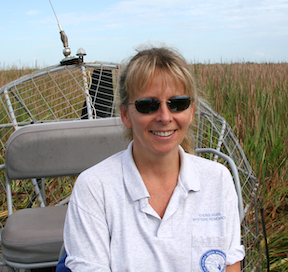
“As part of my undergrad degree, I did this course on alternative energy,” Newman explained. “I got a lot of information from the University of Florida that talked about growing water hyacinth on sewage and converting it to biogas.”
The environmental aspect of the subject and the chemistry involved was a perfect fit. She corresponded with the UF researchers involved and it led to her getting an assistantship in the Agronomy Department. Newman completed a master’s degree with Dr. Bill Haller as her advisor.
“I looked at the mineral nutrition of water hyacinth,” she said. “Dr. Ramesh Reddy was on my committee because he did a lot of work with water hyacinth.”
Reddy was a professor in the Soil and Water Sciences Department at the time. He first met Newman when she asked him to serve on her M.S. thesis committee.
“I was so impressed with her thought process and curiosity in asking me questions related to aquatic plants and their role in the environment,” Reddy recalled. “She wanted to do something unique and different in her research and she did in identifying nutrient deficiencies in aquatic plants.”
“What I realized in doing my master’s was that I loved science,” Newman said. “I like to do experiments and I love to do research. I like to ask questions and answer them. And so, I wanted to do a Ph.D.”
She looked at different doctoral programs in the United States and Australia. Newman also talked with Reddy about the possibility of doing her doctoral work with him. She thought it would be a good opportunity to link the two things she liked – chemistry and the environment – with the research his lab was undertaking.
“When Sue asked me if she can work in our lab for her Ph D. I did not hesitate a bit and asked her when she can start,” Reddy said. “During a few meetings after that, she asked me several insightful and out the box questions to find out a theme for her dissertation. Subsequently, her research resulted in establishing a new program to study the role of enzymes in aquatic ecosystems.”
Doctoral Program
Dr. Reddy’s research lab was up and running before Sue Newman started her doctoral studies. Still, it was growing in size and broadening its wetland biogeochemistry research. Newman remembered the lab research was nutrient-related, with the primary expertise being in nitrogen cycling. She was interested in phosphorus, but her background was in chemistry.
“I’d become familiar with Lake Apopka from the water hyacinth perspective (during her master’s studies). And so, we ended up coming up with a project that looked at phosphorus cycling in Lake Apopka for my Ph.D.,” Newman explained.
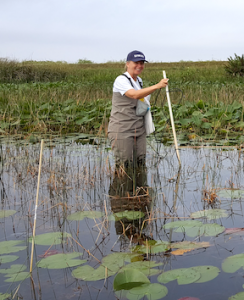
She says that is how she evolved from being a chemistry major interested in the environment to studying chemistry in the environment.
Newman remembers working in the lab as a highlight of her Ph.D. experience. At the time, there were several postdocs and many graduate students. They came from different countries, both men and women. She said there was great diversity, but they all became like a family.
“I felt that I was very much a part of something in that lab. The atmosphere was incredible,” she said. “People were with you all the time; it didn’t matter the time of day. It could be ten pm on a weekend and you wouldn’t be the only one who was there.”
With her family in England, Newman felt her lab family provided a lot of support. That came in the form of listening to her concerns and socializing. It also helped to have someone to aid in her fieldwork. In turn, she helped out her lab mates, some of whom she still stays in contact.
“Another nice thing about Ramesh’s lab is that everybody was working on big projects,” Newman said. “He had a very large Lake Okeechobee project at the time, and also a large Lake Apopka project. He had both lakes and wetlands projects ongoing and so we were aware of a lot of different things that people were doing.”
Newman remembers her doctoral program as running smoothly. She took interesting and relevant classes. Her minor was in environmental engineering studies, which complimented her major studies. She said the physical process of writing the dissertation was the most difficult.
“The last few months were grueling in terms of getting everything done,” she said. “Computers were so expensive that most of us didn’t have our own, so you always have to be in the lab. You couldn’t sit in quiet at home and write your dissertation.”
At the same time, Newman was considering what to do next. She was considering post-doctoral positions because she wanted to continue to do research. But then she saw a position with the South Florida Water Management District. Its focus was on using constructed wetlands to remove phosphorus in an effort to protect the Everglades. She applied for it.
“I didn’t find out that they’d even receive my application, other than Ramesh, called me into his office one day and said, ‘Oh, by the way, there are some water management district people having a meeting on campus and they’re wondering if they could interview for that job that you applied for.’”
Newman got the job. She started in April 1991 having already successfully defended her dissertation earlier that spring.
“For the next three decades, I have seen Sue continuously maintain her passion and focus on developing an internationally recognized program at the South Florida Water Management District. It has helped to advance our understanding of phosphorus dynamics in wetlands and aquatic systems,” Reddy said. “I am very proud of her accomplishments. Her research contributions made a significant difference in current efforts to implement restoration strategies in the Everglades.”
Helping the Everglades
During her nearly 30-years with the SFWMD, Sue Newman has worked on several projects aimed at restoring the Everglades. The first task was to establish a research program for the prototype 1544 ha constructed wetland. It was called the Everglades Nutrient Removal Project, now combined within over 23,000 hectares of stormwater treatment areas (STA).
“They needed someone to help design the research program to figure out how to optimize phosphorus removal within a certain area and what type of things to expect,” she explained. “We did plant competition experiments to look at how different plants grew and how they took up nutrients. We worked with engineers to help build some testing components within the project.”
Scale was a big change to me. I was doing bench top scale experiments with soil cores, flasks, and container studies at university. At the District, we’re talking about hands-on, in the landscape manipulations that are at a landscape-scale and it’s just pretty amazing.
Sue Newman
The next team project Newman worked on did research to establish the phosphorus criterion in the Everglades. She conducted phosphorus dosing experiments.
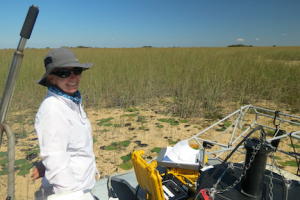
“We did in situ manipulative experiments and monitored nutrient enrichment gradients to try and understand what level of phosphorus would be protective of the Everglades ecosystem,” Newman said. “We did that for about a decade.”
The information would be used to set a phosphorus standard for the Everglades. Her team representing the state was not the only one working on that. A team from Florida International University was conducting research on behalf of the federal government, while agricultural interests funded Duke University’s work. Newman and colleagues presented data at hearings on the matter. SFWMD data were the primary source used by the Department of Environmental Protection when proposing the phosphorus rule that policymakers subsequently supported.
“That’s kind of a big deal,” she explained. “Our data held true and basically our recommendations were the ones that were accepted.”
Having that acceptable level of phosphorus specified led Newman to the next challenge.
“There was a recognition that we needed to do something about restoring the Everglades areas that were already impacted by nutrients and that it would likely take decades, if it was even possible, for them to fix themselves, but maybe there is something that we can do,” she explained.
Cattail Habitat Improvement Project
Cattails covered tens of thousands of hectares of the Everglades at the time. They were growing rapidly because of legacy phosphorus in the soil. The Cattail Habitat Improvement Project (CHIP) proposed removing the dense cattail stands to create open water areas. The idea is open-water habitat improves ecosystem structure.
“Almost immediately the water became re-oxygenated and submerged aquatic plants began to grow,” Sue Newman recalled. “Fourteen years later, we have found the surface soils being created in these plots have reduced phosphorus levels, suggesting we might be able to reverse decades of eutrophication.”
Wildlife populations have also increased, such as fish, wading birds, and ducks. They also made a discovery about alligators in the area. A colleague compared 1940s aerial imagery of one of the CHIP areas that had been treated. It showed one of the alligator trails in a restored site was the same in the 1940s. The same turned out to be true of other treated areas.
“Our hypothesis is alligators had been living in cattail for 60 years or more and we didn’t think they really were in that area because it’s really dense with cattail,” said Christa Zweig, a UF alumna and SFWMD ecologist who works with Newman.
Clearing away some cattail and exposing the alligators showed the reptiles are more resilient than first thought. It is an area of research Zweig hopes to pursue with Newman’s help and encouragement.
“Sue wants to help everybody develop skills, whether it’s building on something they already know or new skills,” Zweig explained. “She really cares about people developing their scientific skills and I think that’s impressive.”
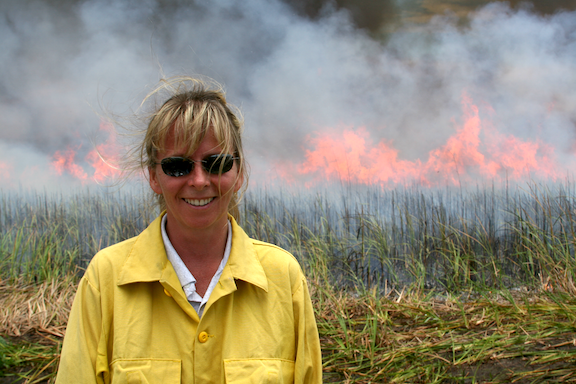
Plenty of Projects
Sue Newman works with different SFWMD teams in a variety of ways, but each is interconnected. How can we restore flow through the Decompartmentalization Physical Model (DPM) project and not cause local nutrient enrichment of the Everglades? How does backfilling canals influence their dynamics? What strategies can we use to actively improve the marsh? Impacts on flora and fauna? The list goes on and on.
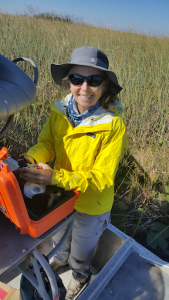
“We’re kind of moving forward with – how do we continue to learn from this project in terms of an adaptive management strategy?” Newman said. “We continue to learn and influence the operations and design of other aspects of restoration. We feel like we’ve accomplished so much because we can actually help people make decisions about how to restore the landscape.”
And for Sue Newman, it all connects to phosphorus.
“I’m working on a lot of different large-scale projects,” she said, “basically measuring all different components of the ecosystem with my role being the phosphorus aspect of it.”
“I was at the right place at the right time,” Newman said of her hiring at SFWMD. “They were building the Everglades program when I first arrived, so I was very fortunate that we had a lot of questions that needed to be answered. And we still do.”
 0
0
